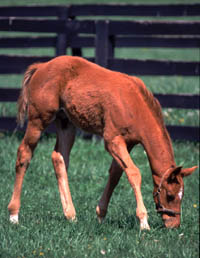Important Foaling Reminders for Kentucky Horse Owners and Breeders
Important Foaling Reminders for Kentucky Horse Owners and Breeders

Newborn foals bounding across Bluegrass pastures is a sign to Kentuckians that spring is on the way. Horse owners and breeders can make the foaling process easier on themselves and their mares by paying careful attention to some important details.
“The biggest thing is making sure the mare’s vaccination and worming programs are up-to-date, so that the colostrum will be good quality,” said University of Kentucky horse specialist Bob Coleman. “And to follow up with that, make sure the foal has enough colostrum. If the mare’s been streaming milk two weeks prior to foaling, chances are there won’t be enough colostrum. If you aren’t sure what to do, talk to a veterinarian. Some vets will have a supply of colostrum on hand, check with them if you need it.”
Mares carry their foals anywhere from 335 to 342 days, depending on such factors as the foal’s sex and the time of year. Coleman suggested that mares be moved to the foaling area between four and six weeks before the estimated foaling date, so they can become comfortable.
“Because foaling areas are usually so much closer to the main farm facility, it’s easier to keep an eye on mares, especially at night, “ he said.
Once the foaling process begins, it usually goes in three stages. Stage I is the preparation phase and Coleman said it can last from 30 minutes to several hours. The mare will be experiencing contractions and may appear restless and the owner may think she is experiencing mild colic. When the mare’s water breaks, releasing amniotic fluid to lubricate the birth canal, stage II is about to begin.
Delivery of the foal is stage II, lasting anywhere from 20 to 30 minutes. The mare will have strong contractions. When the foal begins to appear, its front feet should come first and be facing down, Coleman said.
“After the foal is out, make sure the sac is broken so the foal will be able to breathe,” he said. “It’s not uncommon for the pair to rest up to 20 minutes after birth.”
The expulsion of the placenta is stage III and it occurs 30 minutes to three hours after delivery. If the placenta has not been delivered after four hours, Coleman recommended calling a veterinarian.
After the foal has been delivered and has had a chance to rest, Coleman said special care should be taken to make sure the umbilical cord is treated with an antibacterial solution to prevent infection. Since foals usually want to start nursing anywhere from 30 minutes to two hours after birth, Coleman said it is a good idea to wash the mare’s udder.
“It’s very important for foals to receive the first milk,” he said. “It contains colostrum, which gives foals the antibodies they need until their own immune system is strong enough to produce them. Because of the nature of colostrum, the foal needs to consume it in the first six to eight hours and by 24 hours of age.”
Also, the foal should pass its first waste, called mecomium, within the first 12 hours of life.
Coleman said if the weather is nice, it’s good to get the foals outside as soon as possible. But he also cautioned that weaker foals should be given time inside to catch up and rest and not be pushed to go out too soon.
“As much as you should be aware of what’s going on during the foaling process, and as exciting as it is to watch a foal be born, don’t get too carried away,” he said. “Let a mare be a mare and a foal be a foal, and just don’t intrude anymore than necessary.”
